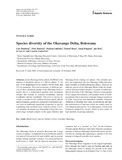Please use this identifier to cite or link to this item:
http://hdl.handle.net/10311/1197Full metadata record
| DC Field | Value | Language |
|---|---|---|
| dc.contributor.author | Ramberg, L. | - |
| dc.contributor.author | Hancock, P. | - |
| dc.contributor.author | Lindholm, M. | - |
| dc.contributor.author | Meyer, T. | - |
| dc.contributor.author | Ringrose, S. | - |
| dc.contributor.author | Sliva, J. | - |
| dc.contributor.author | Vanderpost, C. | - |
| dc.date.accessioned | 2014-02-05T08:30:49Z | - |
| dc.date.available | 2014-02-05T08:30:49Z | - |
| dc.date.issued | 2006 | - |
| dc.identifier.citation | Ramberg, L. et al. (2006) Species diversity of the Okavango Delta, Botswana, Aquatic sciences, vol. 68 no.3, p. 310-337. | en_US |
| dc.identifier.uri | http://hdl.handle.net/10311/1197 | - |
| dc.description.abstract | In the Okavango Delta (about 28,000 km2) the number of identified species is 1,300 for plants, 71 for fish, 33 for amphibians, 64 for reptiles, 444 for birds, and 122 for mammals. The local occurrence of different species of these taxonomic groups in the Okavango Delta is mainly due to a hydrological gradient from permanent streams and swamps to seasonal floodplains, riparian woodlands, and dry woodlands. This level of species diversity is normal for the southern African region, and all analyzed aquatic groups are composed of ubiquitous species with an additional significant proportion of species originating from northern, more tropical systems. Cyclical variations in climate over thousands of years have created a huge wetland complex in the upper Zambezi and Okavango Rivers during wet phases. This wetland complex has fragmented into the Okavango Delta and other large wetlands in Zambia during dry phases. There are no endemic species in the Okavango Delta while the South-central African wetland complex is a centre of endemism. Species diversity of the Okavango Delta is a consequence of this unique environment, with dynamic shifts in flooding patterns that in turn force constant changes in patterns of plant succession and dependent animals. Temporal variations in flooding also cause accumulation and sudden mobilization of nutrients which are readily used by well adapted plant species. As a consequence, locally high biological productivity occurs, which in turn results in high numbers of grazing mammals. | en_US |
| dc.language.iso | en | en_US |
| dc.publisher | Springer link, http://link.springer.com | en_US |
| dc.subject | Species | en_US |
| dc.subject | Habitat | en_US |
| dc.subject | Wetlands | en_US |
| dc.subject.lcsh | Biodiversity | en_US |
| dc.title | Species diversity of the Okavango Delta, Botswana | en_US |
| dc.type | Published Article | en_US |
| dc.link | http://link.springer.com/article/10.1007/s00027-006-0857-y# | en_US |
| Appears in Collections: | Research articles (ORI) | |
Files in This Item:
| File | Description | Size | Format | |
|---|---|---|---|---|
| species diversity-OK delta-Ramberg.pdf | 768.39 kB | Adobe PDF |  View/Open |
Items in DSpace are protected by copyright, with all rights reserved, unless otherwise indicated.
